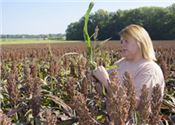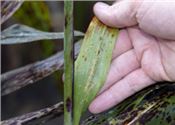|
MSU Sorghum Research Focuses On Aphid Control

Brittany Lipsey, a Mississippi State University graduate student from Louisville, Mississippi,
is researching management techniques that can be used to combat sugarcane aphids,
helping sorghum farmers have a sustainable future with the crop.
Photos by MSU Extension Service/Kevin Hudson
STARKVILLE, MISS.
Fewer Mississippi producers are looking at grain sorghum as a crop rotation option since an introduced pest became a major problem, a trend Mississippi State University researchers are working to reverse.
The sugarcane aphid is a nonnative pest introduced to the United States in Florida in 1977. By the late 1990s, it had been found in Louisiana. In both states, the pest initially fed on sugarcane. At some point, the aphid began feeding on Johnsongrass, a significant weed found in sugarcane and other crops in the Midsouth.
From Johnsongrass, the pest transitioned to the closely related field crop, grain sorghum. In 2013, sugarcane aphids were first found in sorghum in several areas of Louisiana and Texas and in one Mississippi county.
Mississippi had more than 120,000 acres of sorghum in 2015. Growers planted just 13,000 acres in 2016. Low prices also were a major factor in reducing the state’s acreage.
“It can be a catastrophic problem,” said Erick Larson, grain specialist with the MSU Extension Service. “Controlling sugarcane aphids in grain sorghum requires intensive scouting and will likely include multiple insecticide applications throughout the year. For those who aren’t familiar with the insect, it can sneak up on you if you’re not scouting on a regular basis.”
Sugarcane aphids were first found on sorghum in Mississippi in one Bolivar County field, said Jeff Gore, Extension entomologist who also works with the Mississippi Agricultural and Forestry Experiment Station at the Delta Research and Extension Center in Stoneville.
“The first treatment of sugarcane aphids occurred in 2014,” Gore said. “It started off fairly isolated, then it spread rapidly not only through Mississippi, but into Alabama, Tennessee and Arkansas. Now it is in every area where we grow grain sorghum in the U.S. and has recently been found in Arizona and California.”
Aphids have piercing, sucking mouthparts they use to filter plant juices to get the nutrients they need. They secrete a sticky substance known as honeydew.
“Sugarcane aphids appear to be a much more aggressive feeder than other aphids, so they produce a lot of honeydew,” Gore said. “High populations, combined with them being aggressive feeders, create much more honeydew than other aphid pests, and this can create problems at harvest with all of the sticky plant material choking up combines.”
If these aphids are not properly managed or controlled, honeydew can be such a problem at harvest that many producers make insecticide applications with desiccants to keep the pests out of sugarcane heads and cut back the sticky secretions. In some cases, growers pull water trailers through fields where aphids were not adequately managed before harvest. They periodically stop to spray the sugary substance out of the machinery.
Controlling sugarcane aphids is not difficult, but it drives up expenses, making the crop an unattractive option unless prices are high. Mississippi farmers have historically planted around 70,000 acres of sorghum each year. The crop rotates well with cotton and soybeans, as it helps with weed management by allowing growers to fight weeds with different chemicals.
“Most of our growers in Mississippi grow grain sorghum as a rotation crop on marginal soil,” Gore said. “They look at it as a crop they can plant for a year and help with weed management.”
Extension entomologist Angus Catchot said MSU is working on several different approaches to solve the problem of sugarcane aphids in grain sorghum.
“It’s a new pest, and we’re working to collect the data to provide answers for our farmers,” Catchot said. “We’re looking at different options for chemical control, sampling methodology in scouting, and cultural practices that can combat the pest.”
Brittany Lipsey, an agricultural and life sciences graduate student from Louisville, Mississippi, conducts sugarcane aphid research to develop better management so that sorghum farmers can have a sustainable future with the crop.
“I am looking at the use of seed treatments for early season control to see if it will hold the aphids off until later in the plant development when the plant is less susceptible to major damage,” Lipsey said. “Certain stages when the sorghum plant is putting all its energy and nutrients into head development is the worst time to have heavy aphid pressure.
“Planting dates are an effective way to avoid heavy insect pressures, so we are assessing when is the best time to plant to avoid infestations but also produce the best yield,” she said.
A second project is examining planting populations to see if the number of plants per acre affects aphid densities on the plants. Lipsey is also looking at the effects of air temperature on the performance of two insecticides that are sprayed on plant leaves.
“Farmers in Mississippi need a plan to tackle the sugarcane aphid,” Lipsey said. “I hope the data I am gathering will be able to set a plan from planting to harvest to maximize yield even under aphid conditions.” ∆

Sugarcane aphids can be seen as dozens of yellowish dots on the surface of this grain sorghum leaf
on Sept. 15, 2016, on a Mississippi State University research field in Starkville. Aphids secrete a
sticky substance known as honeydew after drawing nutrients from host plants.
|
|